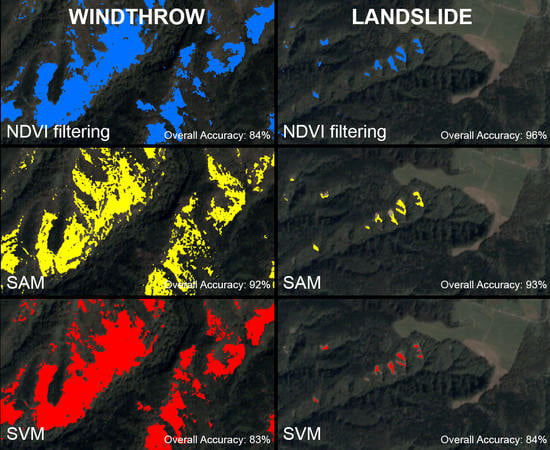Comparison of Conventional Change Detection Methodologies Using High-Resolution Imagery to Find Forest Damage Caused by Typhoons
Abstract
:1. Introduction
2. Materials and Methods
2.1. Typhoons and The Study Area
2.2. Remote Sensing Dataset
2.3. Windthrow and Landslide Detection
2.3.1. Normalized Difference Vegetation Index Filtering Method
2.3.2. Spectral Angle Mapper Method
2.3.3. Support Vector Machine Method
2.4. Assessment
3. Results
3.1. Windthrow Detection
3.2. Landslide Detection
4. Discussion
4.1. Windthrow Detection
4.2. Landslide Detection
5. Conclusions
Supplementary Materials
Author Contributions
Funding
Acknowledgments
Conflicts of Interest
References
- Yamamoto, S.-I. Gap dynamics in climaxFagus crenata forests. Bot. Mag. Tokyo 1989, 102, 93–114. [Google Scholar] [CrossRef]
- Mabry, C.M.; Hamburg, S.P.; Lin, T.-C.; Horng, F.-W.; King, H.-B.; Hsia, Y.-J. Typhoon Disturbance and Stand-level Damage Patterns at a Subtropical Forest in Taiwan1. Biotropica 1998, 30, 238–250. [Google Scholar] [CrossRef]
- Dale, V.H.; Joyce, L.A.; McNulty, S.; Neilson, R.P.; Ayres, M.P.; Flannigan, M.D.; Hanson, P.J.; Irland, L.C.; Lugo, A.E.; Peterson, C.J.; et al. Climate Change and Forest Disturbances. Bioscience 2001, 51, 723. [Google Scholar] [CrossRef] [Green Version]
- Murakami, H.; Wang, Y.; Yoshimura, H.; Mizuta, R.; Sugi, M.; Shindo, E.; Adachi, Y.; Yukimoto, S.; Hosaka, M.; Kusunoki, S.; et al. Future Changes in Tropical Cyclone Activity Projected by the New High-Resolution MRI-AGCM. J. Clim. 2012, 25, 3237–3260. [Google Scholar] [CrossRef]
- Van Westen, C.J. Remote sensing for natural disaster management. Int. Arch. Photogramm. Remote Sens. Spat. Inf. Sci. ISPRS Arch. 2000, 33, 1609–1617. [Google Scholar]
- Boccardo, P.; Giulio Tonolo, F. Remote Sensing Role in Emergency Mapping for Disaster Response. In Engineering Geology for Society and Territory-Volume 5; Lollino, G., Manconi, A., Guzzetti, F., Culshaw, M., Bobrowsky, P., Luino, F., Eds.; Springer International Publishing: Cham, Switzerland, 2015; pp. 17–24. ISBN 978-3-319-09048-1. [Google Scholar]
- Rozenstein, O.; Karnieli, A. Comparison of methods for land-use classification incorporating remote sensing and GIS inputs. Appl. Geogr. 2011, 31, 533–544. [Google Scholar] [CrossRef]
- Rwanga, S.S.; Ndambuki, J.M. Accuracy Assessment of Land Use/Land Cover Classification Using Remote Sensing and GIS. Int. J. Geosci. 2017, 08, 611–622. [Google Scholar] [CrossRef] [Green Version]
- Bolstad, P.V.; Gessler, P.; Lillesand, T.M. Positional uncertainty in manually digitized map data. Int. J. Geogr. Inf. Syst. 1990, 4, 399–412. [Google Scholar] [CrossRef]
- Fonji, S.F.; Taff, G.N. Using satellite data to monitor land-use land-cover change in North-eastern Latvia. Springerplus 2014, 3, 61. [Google Scholar] [CrossRef] [Green Version]
- Klemas, V.V. The Role of Remote Sensing in Predicting and Determining Coastal Storm Impacts. J. Coast. Res. 2009, 256, 1264–1275. [Google Scholar] [CrossRef] [Green Version]
- Joyce, K.E.; Wright, K.C.; Samsonov, S.V.; Ambrosia, V.G. Remote sensing and the disaster management cycle. In Advances in Geoscience and Remote Sensing; InTech: London, UK, 2009; pp. 317–346. [Google Scholar]
- Okamoto, K.; Fukuhara, M. Estimation of paddy field area using the area ratio of categories in each mixel of Landsat TM. Int. J. Remote Sens. 1996, 17, 1735–1749. [Google Scholar] [CrossRef]
- Hamdi, Z.M.; Brandmeier, M.; Straub, C. Forest Damage Assessment Using Deep Learning on High Resolution Remote Sensing Data. Remote Sens. 2019, 11, 1976. [Google Scholar] [CrossRef] [Green Version]
- Mokroš, M.; Výbošťok, J.; Merganič, J.; Hollaus, M.; Barton, I.; Koreň, M.; Tomaštík, J.; Čerňava, J. Early Stage Forest Windthrow Estimation Based on Unmanned Aircraft System Imagery. Forests 2017, 8, 306. [Google Scholar] [CrossRef] [Green Version]
- Wu, C.; Du, B.; Cui, X.; Zhang, L. A post-classification change detection method based on iterative slow feature analysis and Bayesian soft fusion. Remote Sens. Environ. 2017, 199, 241–255. [Google Scholar] [CrossRef]
- Einzmann, K.; Immitzer, M.; Böck, S.; Bauer, O.; Schmitt, A.; Atzberger, C. Windthrow Detection in European Forests with Very High-Resolution Optical Data. Forests 2017, 8, 21. [Google Scholar] [CrossRef] [Green Version]
- Kupfer, J.A.; Emerson, C.W. Remote Sensing. In Encyclopedia of Social Measurement; Elsevier: Amsterdam, The Netherlands, 2005; Volume 3, pp. 377–383. [Google Scholar]
- Wang, J.; Sheng, Z.; Yu, H. Popularization of remote sensing education and general course construction in undergraduate education. IOP Conf. Ser. Earth Environ. Sci. 2014, 17, 012262. [Google Scholar] [CrossRef] [Green Version]
- Forest Management Division, Bureau of Forestry, Department of Fisheries and Forestry, Hokkaido Government. Forest Management to Reduce the Risk of Damage of Windthrow. 2018. (In Japanese). Available online: http://www.pref.hokkaido.lg.jp/sr/srs/riskdown.pdf (accessed on 5 October 2020).
- Olofsson, P.; Foody, G.M.; Stehman, S.V.; Woodcock, C.E. Making better use of accuracy data in land change studies: Estimating accuracy and area and quantifying uncertainty using stratified estimation. Remote Sens. Environ. 2013, 129, 122–131. [Google Scholar] [CrossRef]
- Tsai, F.; Lin, T.-H.; Chen, L.-C.; Chen, W.W. Landslide detection and monitoring using remote sensing and spatial analysis in Taiwan. In Proceedings of the Earth Resources and Environmental Remote Sensing/GIS Applications II; Michel, U., Civco, D.L., Eds.; International Society for Optics and Photonics: Bellingham, WA, USA, 2011; Volume 8181, p. 81810V. [Google Scholar]
- Gorelick, N.; Hancher, M.; Dixon, M.; Ilyushchenko, S.; Thau, D.; Moore, R. Google Earth Engine: Planetary-scale geospatial analysis for everyone. Remote Sens. Environ. 2017, 202, 18–27. [Google Scholar] [CrossRef]
- Japan Meteorological Agency. Disaster Meteorological Report-Heavy Rain and Storms from 2016 August 16 to August 31 due to Typhoon No. 7, No. 9, No. 10, No. 11 and Front Line in 2016; Japan Meteorological Agency: Tokyo, Japan, 2017. [Google Scholar]
- Planet Lab Inc. PLANET IMAGERY AND ARCHIVE. Available online: https://www.planet.com/products/planet-imagery/ (accessed on 6 June 2020).
- Japanese Ministry of Land Infrastructure Transport and Tourism National Land Numerical Information Download Service. Available online: https://nlftp.mlit.go.jp/ksj/index.html (accessed on 24 September 2020).
- Maxar Technologies WORLDVIEW-2. Available online: https://www.maxar.com/constellation (accessed on 6 June 2020).
- Rouse, J.W.; Hass, R.H.; Schell, J.A.; Deering, D.W. Monitoring vegetation systems in the great plains with ERTS. Third Earth Resour. Technol. Satell. Symp. 1973, 1, 309–317. [Google Scholar]
- Kruse, F.A.; Lefkoff, A.B.; Boardman, J.W.; Heidebrecht, K.B.; Shapiro, A.T.; Barloon, P.J.; Goetz, A.F.H. The spectral image processing system (SIPS)-interactive visualization and analysis of imaging spectrometer data. In Proceedings of the AIP Conference Proceedings; AIP: College Park, MD, USA, 1993; Volume 283, pp. 192–201. [Google Scholar]
- Congedo, L. Semi-Automatic Classification Plugin Documentation. Release 6.0.1.1. Release 2016, 4, 29. [Google Scholar] [CrossRef]
- QGIS Development Team QGIS Geographic Information System 2009. Available online: https://qgis.org/en/site/ (accessed on 5 October 2020).
- Cortes, C.; Vapnik, V. Support-vector networks. Mach. Learn. 1995, 20, 273–297. [Google Scholar] [CrossRef]
- Sharma, V.; Baruah, D.; Chutia, D.; Raju, P.; Bhattacharya, D.K. An assessment of support vector machine kernel parameters using remotely sensed satellite data. In Proceedings of the 2016 IEEE International Conference on Recent Trends in Electronics, Information & Communication Technology (RTEICT), Bangalore, India, 20–21 May 2016; IEEE: Piscataway, NJ, USA, 2017; pp. 1567–1570. [Google Scholar] [CrossRef]
- Story, M.; Congalton, R.G. Remote Sensing Brief Accuracy Assessment: A User’s Perspective. Photogramm. Eng. Remote Sens. 1986, 52, 397–399. [Google Scholar]
- Cohen, J. A Coefficient of Agreement for Nominal Scales. Educ. Psychol. Meas. 1960, 20, 37–46. [Google Scholar] [CrossRef]
- Llano, X.C. AcATaMa-QGIS Plugin for Accuracy Assessment of Thematic Maps, version 19.11; 2019. Available online: https://smbyc.github.io/AcATaMa (accessed on 5 October 2020).
- Donner, A.; Shoukri, M.M.; Klar, N.; Bartfay, E. Testing the equality of two dependent kappa statistics. Stat. Med. 2000, 19, 373–387. [Google Scholar] [CrossRef]
- Foody, G.M. Thematic Map Comparison. Photogramm. Eng. Remote Sens. 2004, 70, 627–633. [Google Scholar] [CrossRef]
- Landis, J.R.; Koch, G.G. An Application of Hierarchical Kappa-type Statistics in the Assessment of Majority Agreement among Multiple Observers. Biometrics 1977, 33, 363. [Google Scholar] [CrossRef]
- Mountrakis, G.; Im, J.; Ogole, C. Support vector machines in remote sensing: A review. ISPRS J. Photogramm. Remote Sens. 2011, 66, 247–259. [Google Scholar] [CrossRef]
- Petropoulos, G.P.; Vadrevu, K.P.; Kalaitzidis, C. Spectral angle mapper and object-based classification combined with hyperspectral remote sensing imagery for obtaining land use/cover mapping in a Mediterranean region. Geocarto Int. 2013, 28, 114–129. [Google Scholar] [CrossRef]
- Hsu, C.-W.; Chang, C.-C.; Lin, C.J. A Practical Guide to Support Vector Classification. BJU Int. 2008, 101, 1396–1400. [Google Scholar]
- Danneels, G.; Pirard, E.; Havenith, H.-B. Automatic landslide detection from remote sensing images using supervised classification methods. In Proceedings of the 2007 IEEE International Geoscience and Remote Sensing Symposium, Barcelona, Spain, 23–28 July 2007; IEEE: Piscataway, NJ, USA, 2007; pp. 3014–3017. [Google Scholar]
- Dobrinic, D. Horizontal Accuracy Assessment of Planetscope, Rapideye and Worldview-2 Satellite Imagery. In Proceedings of the International Multidisciplinary Scientific GeoConference Surveying Geology and Mining Ecology Management; SGEM: Sofia, Bulgaria, 2018; Volume 18, pp. 129–136. [Google Scholar]


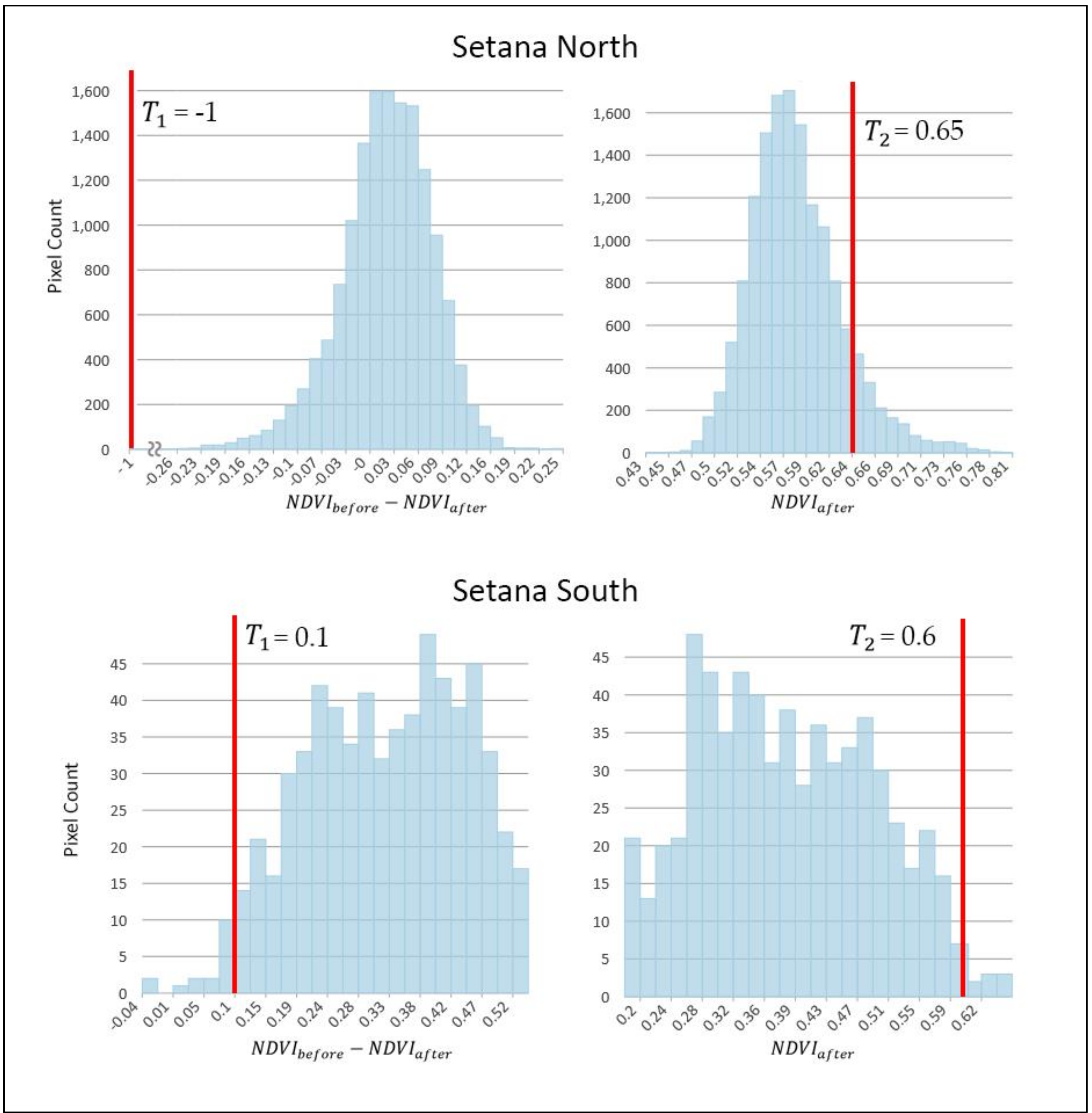

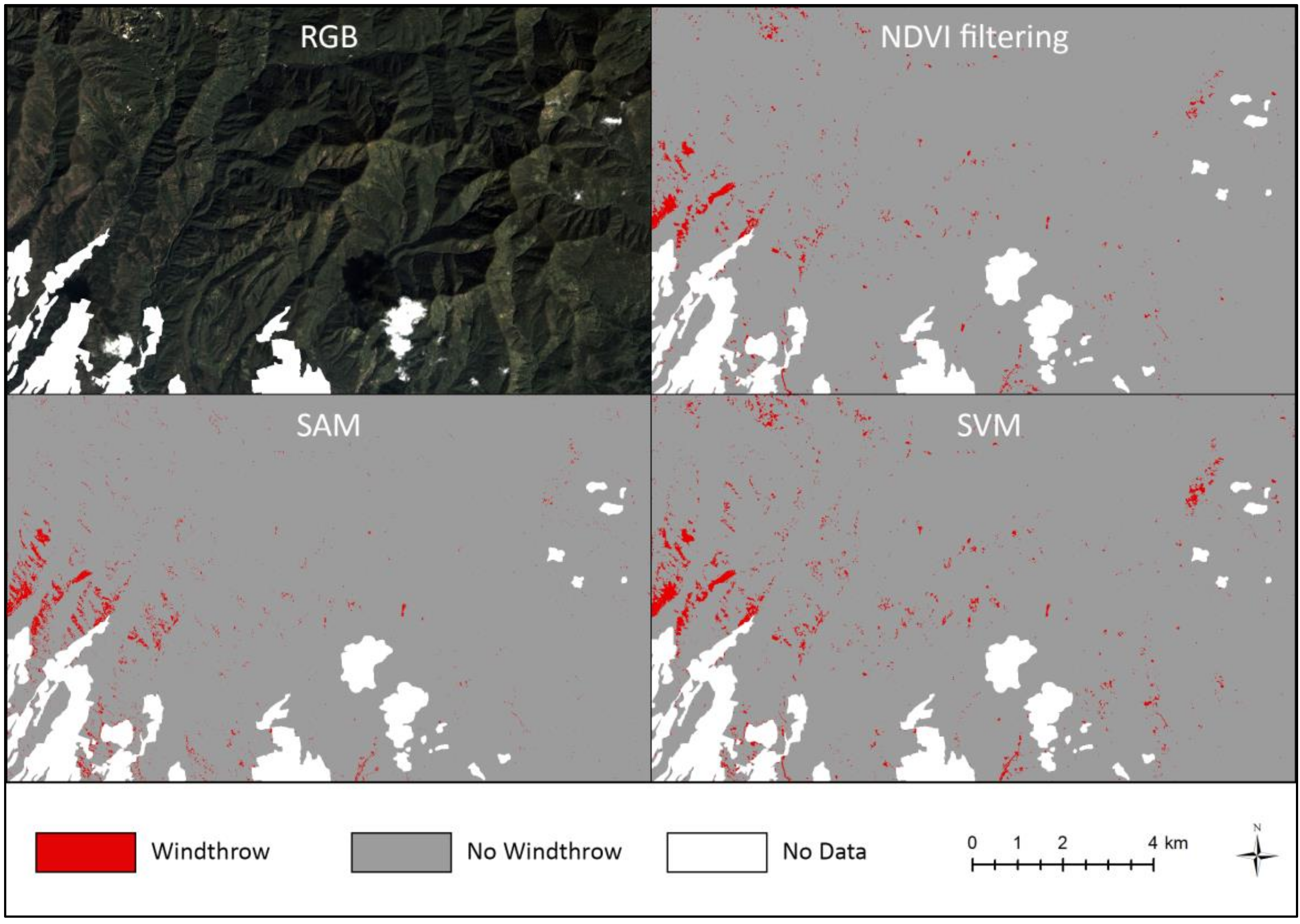


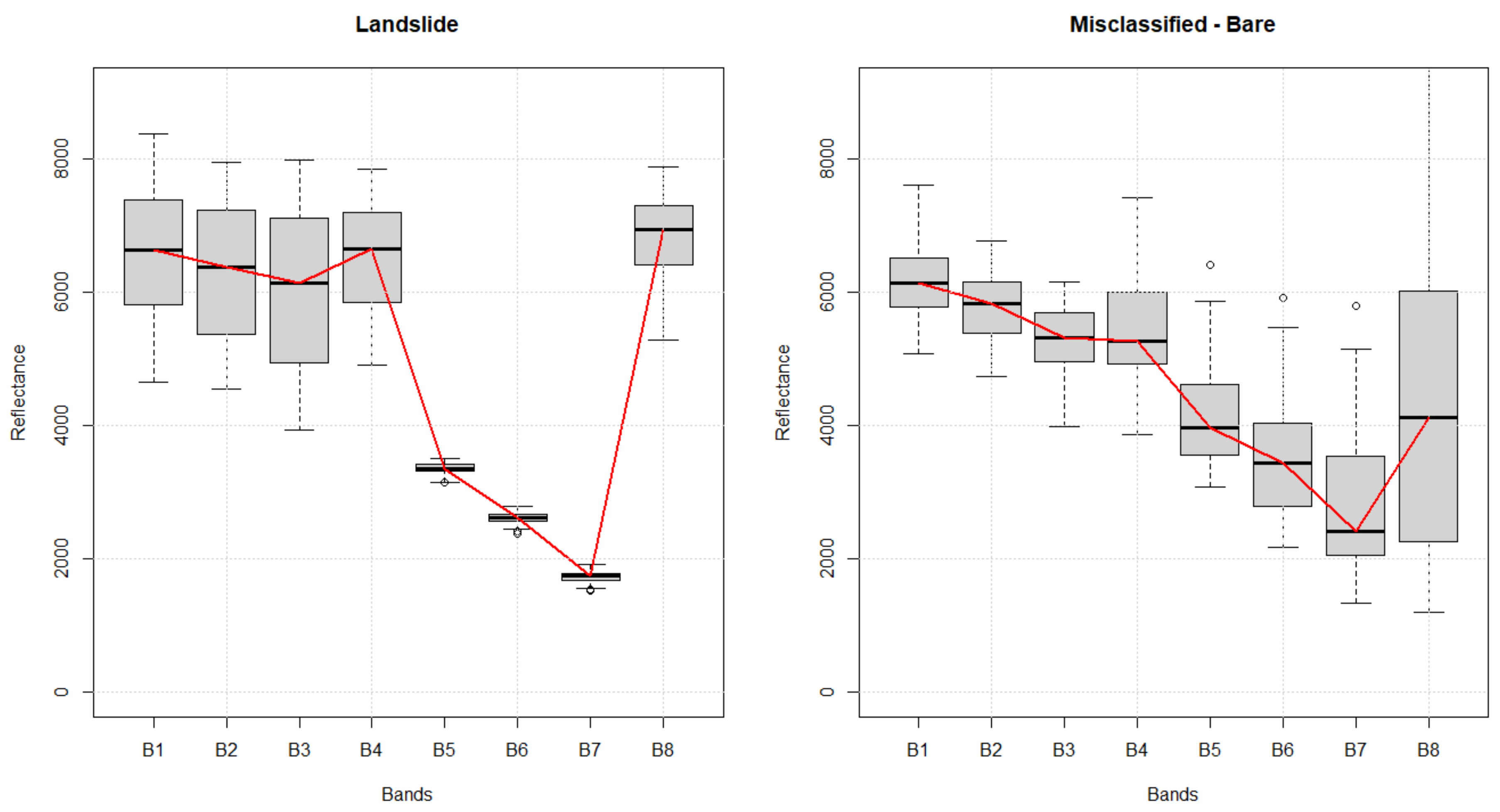
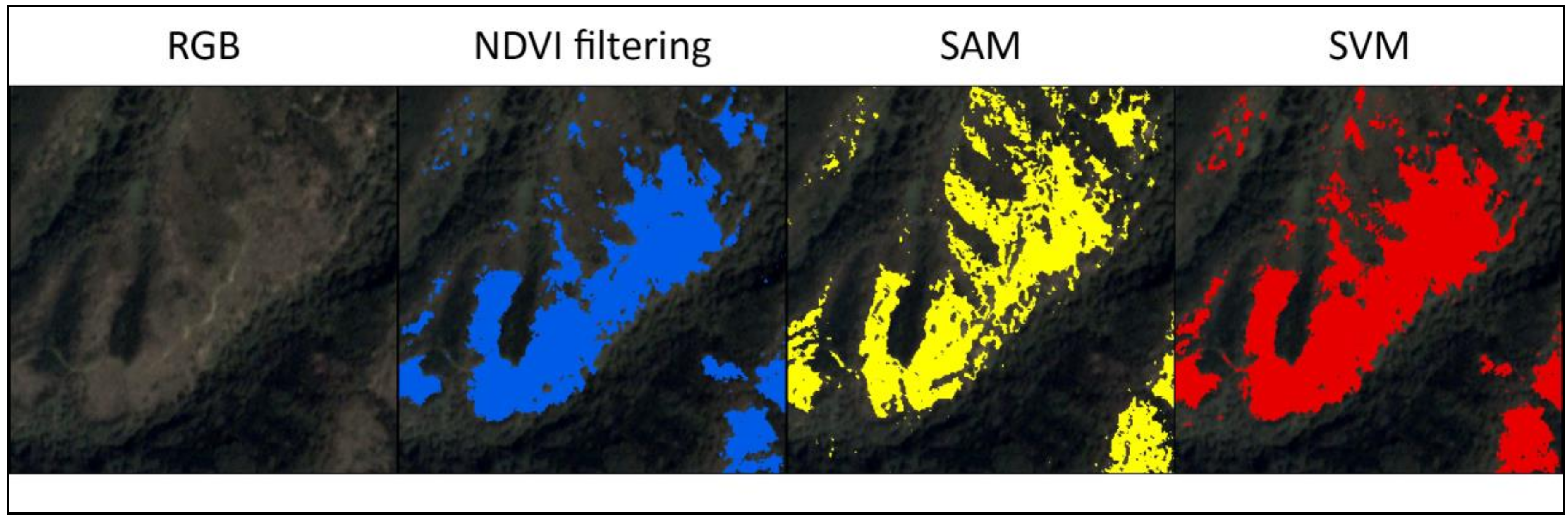

| Reference | Accuracy | Error | ||||||
| Damaged | Nondamaged | Total | UA | Area (ha) | OA | Std Error | ||
| Kappa | ||||||||
| a) Classified by NDVI Filtering | Damaged | 65 | 29 | 94 | 69.1% | 234.0 | 84.0% | 0.0159 |
| Nondamaged | 3 | 103 | 106 | 97.2% | 13625.1 | 0.67 | ||
| Total | 68 | 132 | 200 | |||||
| PA | 95.6% | 78.0% | ||||||
| Damaged | Nondamaged | Total | UA | Area (ha) | OA | Std Error | ||
| Kappa | ||||||||
| b) Classified by SAM | Damaged | 56 | 4 | 60 | 93.3% | 203.3 | 92.0% | 0.0234 |
| Nondamaged | 12 | 128 | 140 | 91.4% | 13655.8 | 0.82 | ||
| Total | 68 | 132 | 200 | |||||
| PA | 82.4% | 97.0% | ||||||
| Damaged | Nondamaged | Total | UA | Area (ha) | OA | Std Error | ||
| Kappa | ||||||||
| c) Classified by SVM | Damaged | 67 | 33 | 100 | 67.0% | 312.8 | 83.0% | 0.0098 |
| Nondamaged | 1 | 99 | 100 | 99.0% | 13546.2 | 0.66 | ||
| Total | 68 | 132 | 200 | |||||
| PA | 98.5% | 75.0% | ||||||
| Bare | Forest | Grassland | Total | |
|---|---|---|---|---|
| NDVI filtering method | 13 | 4 | 12 | 29 |
| SAM method | 0 | 4 | 0 | 4 |
| SVM method | 13 | 5 | 15 | 33 |
| Reference | Accuracy | Error | ||||||
|---|---|---|---|---|---|---|---|---|
| Damaged | Nondamaged | Total | UA | Area (ha) | OA | Std Error | ||
| Kappa | ||||||||
| a) Classified by NDVI Filtering | Damaged | 69 | 7 | 76 | 90.8% | 22.0 | 96.0% | 0.0080 |
| Nondamaged | 1 | 123 | 124 | 99.2% | 8039.0 | 0.91 | ||
| Total | 70 | 130 | 200 | |||||
| PA | 98.6% | 94.6% | ||||||
| Damaged | Nondamaged | Total | UA | Area (ha) | OA | Std Error | ||
| Kappa | ||||||||
| b) Classified by SAM | Damaged | 63 | 7 | 70 | 90.0% | 17.6 | 93.0% | 0.0198 |
| Nondamaged | 7 | 123 | 130 | 94.6% | 8043.2 | 0.85 | ||
| Total | 70 | 130 | 186 | |||||
| PA | 90.0% | 94.6% | ||||||
| Damaged | Nondamaged | Total | UA | Area (ha) | OA | Std Error | ||
| Kappa | ||||||||
| c) Classified by SVM | Damaged | 69 | 31 | 100 | 69.0% | 4.7 | 84.0% | 0.0099 |
| Nondamaged | 1 | 99 | 100 | 99.0% | 8056.1 | 0.66 | ||
| Total | 70 | 130 | 200 | |||||
| PA | 98.6% | 75.0% | ||||||
| Bare | Total | |
|---|---|---|
| NDVI filtering method | 7 | 7 |
| SAM method | 7 | 7 |
| SVM method | 31 | 31 |
© 2020 by the authors. Licensee MDPI, Basel, Switzerland. This article is an open access article distributed under the terms and conditions of the Creative Commons Attribution (CC BY) license (http://creativecommons.org/licenses/by/4.0/).
Share and Cite
Furukawa, F.; Morimoto, J.; Yoshimura, N.; Kaneko, M. Comparison of Conventional Change Detection Methodologies Using High-Resolution Imagery to Find Forest Damage Caused by Typhoons. Remote Sens. 2020, 12, 3242. https://doi.org/10.3390/rs12193242
Furukawa F, Morimoto J, Yoshimura N, Kaneko M. Comparison of Conventional Change Detection Methodologies Using High-Resolution Imagery to Find Forest Damage Caused by Typhoons. Remote Sensing. 2020; 12(19):3242. https://doi.org/10.3390/rs12193242
Chicago/Turabian StyleFurukawa, Flavio, Junko Morimoto, Nobuhiko Yoshimura, and Masami Kaneko. 2020. "Comparison of Conventional Change Detection Methodologies Using High-Resolution Imagery to Find Forest Damage Caused by Typhoons" Remote Sensing 12, no. 19: 3242. https://doi.org/10.3390/rs12193242




